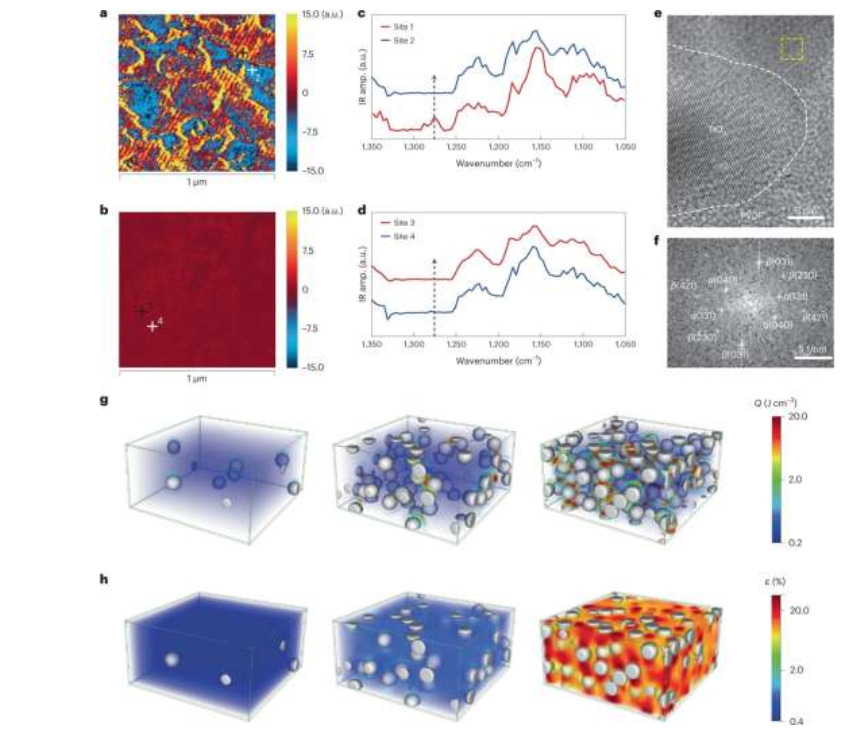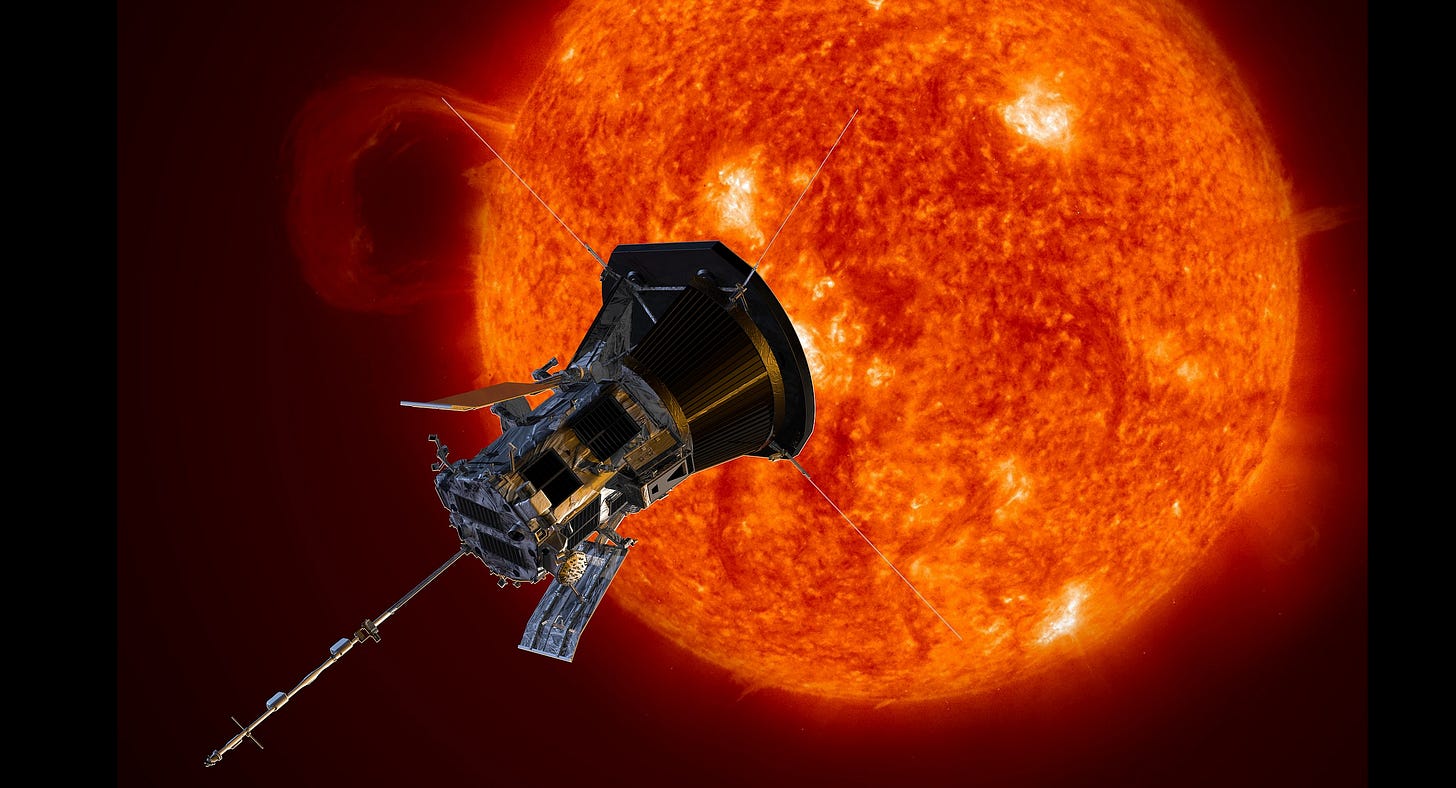This week we examine a new material that may provide soft muscles to robots. We investigate a new Fire Drone that can withstand the temperatures inside fires for long enough to provide firefighters with valuable information to help fight fires. We discover the source of Solar Winds after a recent fly by of the sun by the Parker Solar Probe and finally we ask, ”How old is the Universe?” The answer may be much larger than the currently accepted age.
Muscles for Robots
A team at Penn State have developed a new type of ferroelectric polymer that is exceptionally good at converting electrical energy into mechanical strain. This polymer may be able to be used as a motion controller in medical devices or soft robotics.
Mechanical strain is how a material changes shape when force is applied. This force can be applied via electrical energy. Traditionally used materials are rigid however these polymers have higher flexibility and environmental adaptability. This gives a material that is soft but that can carry a high load in addition to large strain. This mimics human muscle.
There are still challenges with ferroelectric materials however it is likely that we will see them incorporated into various types of soft robotics in the near future.
Fire Drone
A team from Imperial College in London and the The Emma Research Institute are building a fireproof drone. The drone is designed to survive in an intense fire and to provide reconnaissance services for firefighters.
The biggest problem for firefighters is not knowing what they will confront when they get inside a building. Other commercial drones do not last long at all inside a fire. As they get close to a fire the frame melts and the electronics give up. This new drone is designed to last as long as possible inside a building on fire and to provide information whilst it still can.
This new drone can survive temperatures of 200C for at least 10 minutes. Unfortunately house fires can exceed 1,000C. This drone is designed to get as much information as it can before it succumbs. It is a single use drone.
The Fire Drone is equipped with a battery, flight controller, video transmitter, radio receiver, optical camera, infrared camera and CO2 sensors. An insulating layer of aerogel surrounds the electronics. This gel, designed for the project, is composed of polyamide plastic, silica and glass fibers. Air pockets are interspersed throughout the drone. An outer aluminum layer deflects heat away and the glass fiber provides structural support.
The data collected by the drone includes fire sources, hazardous areas to avoid and trapped individuals. A CO2 sensor also provides a cooling effect within the drone whilst the gas evaporates.
The Fire Drone has undergone testing at various firefighting training centers and further trials are underway. There may be additional uses for the drone in forest fires and in cold environments. The insulating gel is also effective at keeping the drone operating in extreme cold.
Parker Solar Probe
Whilst we are talking about fires, the biggest fire in the sky is currently being investigated by the Parker Solar Probe. The probe was launched in 2018 with the mission of investigating the outer corona of the sun. In 2025 it will travel with 6.4 million kilometers of the center of the sun at a speed of 690,000 kph. It is the fastest ever object built by humans.
Last week we spoke about the recent increase in solar activity and the potential impact that may have on earth based communication systems. The forces that generate solar winds are little understood. The power of the winds has made it nearly impossible for spacecraft to see through the chaos and determine where the winds were generated.
Recently the Parker Solar Probe has been able to observe the Sun close enough to image the region where the solar winds originate. It has been theorized that the winds started close to the surface and then gushed through the Sun’s corona. Parker proved that theory correct.
NASA researchers confirmed that the solar wind originates from deep within the open magnetic filed on the Sun called “coronal holes”. These especially bright areas on the Sun are open areas in the Sun’s magnetic field. Multiple magnetic field lines that reach the Sun’s surface pass through each hole. Some lines head towards the sun and others away from it. When these field lines which are going in opposite directions collide, they break and then connect again, spewing out plasma that flows along those lines.
Parker detected flows of highly energetic particles in the plasma that flows out of the coronal holes. These particles are also found in the fast solar wind which travels at up to 800km per second. The Parker Probe equipment is so sensitive, it could detect these winds from 13 million kilometers away.
The early rise in solar activity (see last week) allowed the Parker Probe to investigate this phenomenon earlier than expected (in 2025). Understanding the solar winds should help us predict when they are heading our way and how quickly they will reach Earth. This will help with protection of satellites, electrical grids and other sensitive equipment.
How Old is the Universe?
It has long been thought that the Universe is approximately 13.8 Billion years old however a new theory estimates the age of the Universe as 26.7 Billion years.
Astronomers calculate the age of the universe by measuring the red shift of light coming from the oldest or most distant galaxies. Light from a star does not contain all of the wavelengths in the electromagnetic spectrum. Some of the wavelengths are absorbed by elements in the star. When star light is analyzed the missing colors show as dark lines. Different elements produce different patters of dark lines. When astronomers measure light from distant galaxies these dark lines are moved or shifted towards the red end of the spectrum. This is called red shift.
We see red shift in virtually all galaxies. This is due to the expansion of the space between the Earth and the galaxies. The more red shifted a galaxy, the further away from the earth it is. Using this data we estimated the universe to be 13.797 billion years old. However, there are problems with this method.
The star Methuselah appears to be older than the estimated age of the universe. The James Webb telescope has recently discovered galaxies that are in an advanced state of evolution despite our calculations showing them as being formed 300 millions years after the Big Bang. These galaxies are more consistent in mass and maturity with galaxies that are billions of years old.
In 1929 Fritz Zwicky proposed that the red shift of light from distant galaxies is due to the gradual loss of energy by photons over the vast cosmic distances that they travel. It is known as the tired light theory. Rajendra Gupta from the University of Ottawa has proposed that if this theory coexists with the expanding universe, then, redshift becomes a hybrid phenomenon. Gupta then introduced the coupling constants, i.e. the physical constraints that govern interactions between particles into his calculations. This extended the timeframe for the formation of the galaxies discovered by the JWST from a few hundred million to several billion. This gives a better explanation of the formation of these early galaxies.
Gupta also revises the cosmological constant which represents the dark energy that is responsible for the accelerating expansion of the universe. He proposed a constant that accounts for the evolution of coupling constant. This all leads to the much larger estimated age of the universe of 26.6 Billion years.
Paying it Forward
If you have a start-up or know of a start-up that has a product ready for market please let me know. I would be happy to have a look and feature the startup in this newsletter. Also if any startups need introductions please get in touch and I will help where I can.
If you have any questions or comments please comment below.
I would also appreciate it if you could forward this newsletter to anyone that you think might be interested.
Till next week.







Fascinating edition of your newsletter.